On the fourth day of our trip to Mongolia, we left Ulaanbaatar early in the morning to head to Gorkhi-Terelj National Park. Our itinerary for today includes visiting Old Wooden Bridge, Turtle Rock, and the Aryabal Meditation Temple, horse riding, and visiting the local people. Lastly, we will stay at the traditional Ger.
1. Old wooden bridge
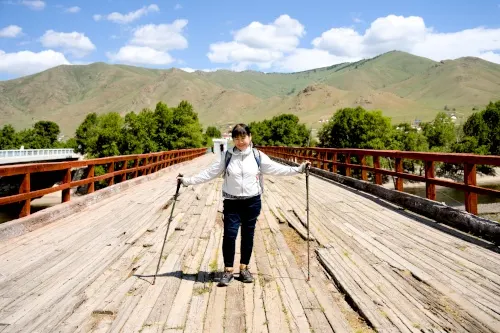
While on its way to Gorkhi Terelj National Park, our coach stopped at an old wooden bridge spanning the serene Tuul River.
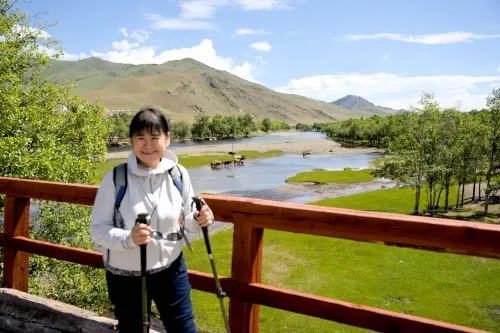
As we walked across the bridge, we were greeted by a breathtaking panorama view on the right—the bridge. Everyone stopped and took multiple photos as the river's waters shimmered in a captivating shade of blue, mirroring the cloudless sky overhead. A small group of horses quenched their thirst, making the scenery even more lively and attractive.
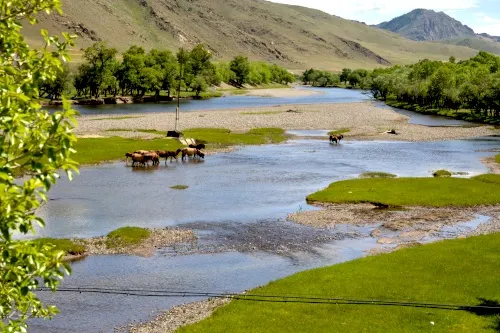
Now I understand why our coach stopped here, asking us to traverse the bridge and absorb the surrounding beauty before picking us up.
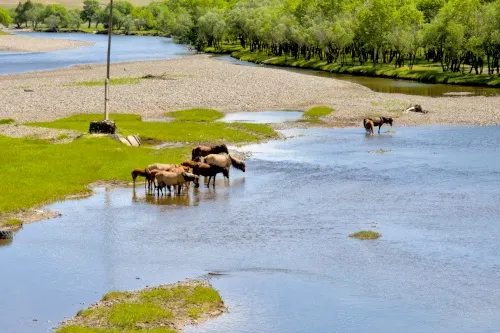
The old wooden bridge was replaced by the new Terelj Bridge, which was built parallel to the left of the old bridge.
The Tuul River is a critical source of drinking water for the people and livestock in the Ulaanbaatar region, as water is extracted from groundwater wells along the river and piped to the city's water supply system.
2. The turtle rock

After crossing the old wooden bridge, our coach continued to Gorkhi Terelj National Park. Our first stop was to visit the rock turtle.
Along the way, our coach passed through vast grasslands with gers dotted in between.

The turtle rock is a large rock standing out on a flat land. Its shape looks like a turtle when viewed from the front or the side. This unique natural formation, Turtle Rock (Melkhii Khad), is located in Gorkhi Terelj National Park, about 55 km northeast of Ulaanbaatar, Mongolia. The rock, which is 24 meters (79 feet) high, has a shape that resembles a turtle. It is located at the foothills of a mountain covered in pine trees.
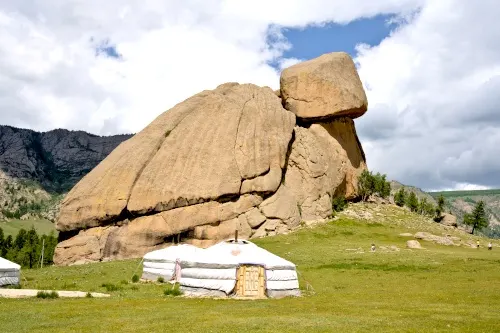
According to local legend, Turtle Rock is a rock of treasure that brings wealth to those who visit. The legend states that the Mongolian historical khan, Galdan Boshugtu, hid his treasures in the rock during a war with Manchu troops in the 1600s.
The rock's unique shape results from the erosive actions of wind and rain over time. Geological processes have carved it into its distinctive turtle-like appearance.
3. Eagle flying
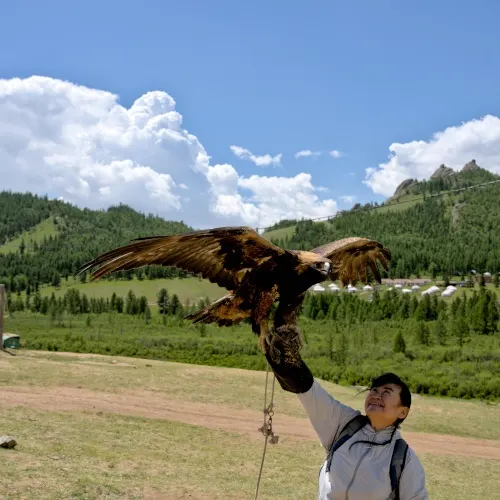
Next to the rock turtle, a local has eagles tethered to a pole as a tourist attraction. Many of us have tried it, and the local person showed us how to perch the eagle on our hands, then shake it to the front and back. The eagle will then understand our command to spread its wings. The experience costs about 8000 Tugrik per person, but it's worth it.
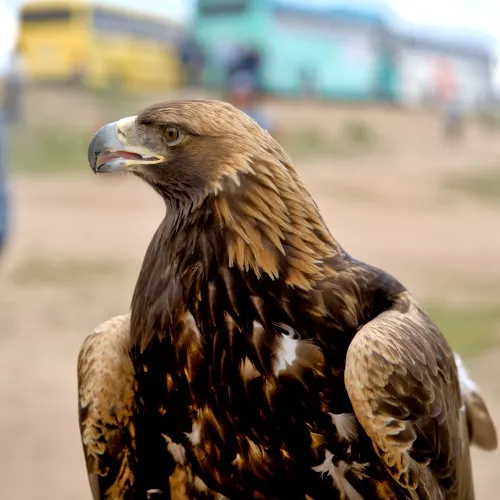
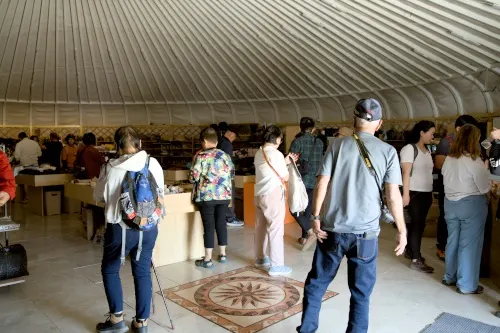
4. Stayed at Alungoo Ger
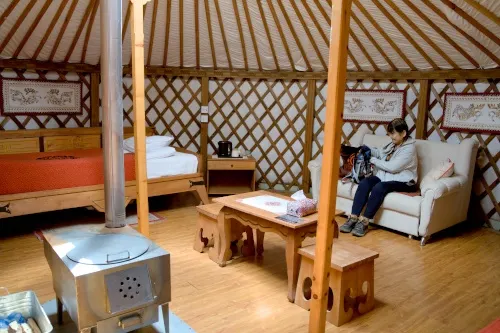
We reached Alungoo Ger, just a few minutes drive from Turtle Rock. It is a relatively new Ger with much better facilities than the one we stayed in the day before. The room is slightly bigger, with an attached bathroom. The main difference between Alungoo and Hoyor Zagal was that no insects were entering the Ger. We were not sure why, but it might be due to the location of the Ger or the weather.
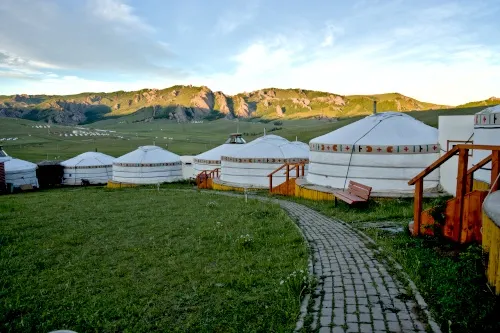
Our next destination is the Aayabal Meditation Temple.
5. Aryabal Meditation Temple
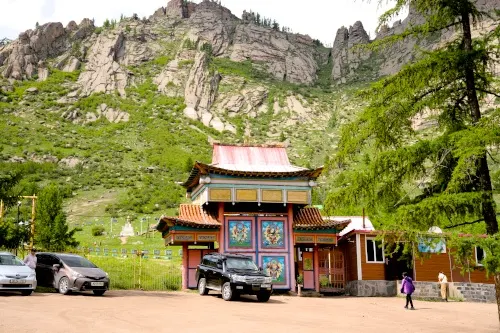
The Aryabal Meditation Temple is near the Turtle Rock. We arrived on a cloudy afternoon, making the walk to the temple quite enjoyable.
There's a cafe before the entrance where you can grab coffee or tea. However, since we were short on time and had other places to visit, we went straight to the temple.
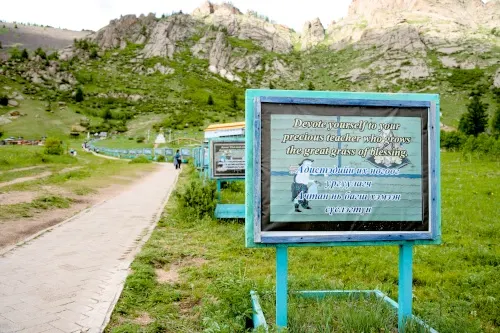
The path to the temple on top of the hill is lined with numerous Buddhist teaching signs in English and Mongolian.
After about a 10-minute walk, we reached a small bridge that led to a staircase leading up to the temple.
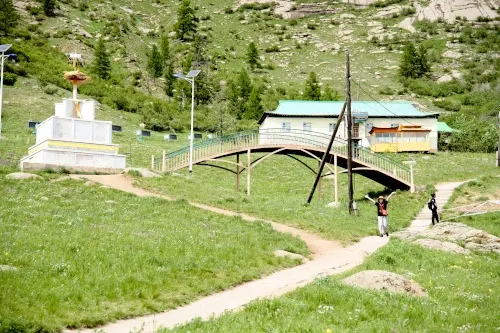
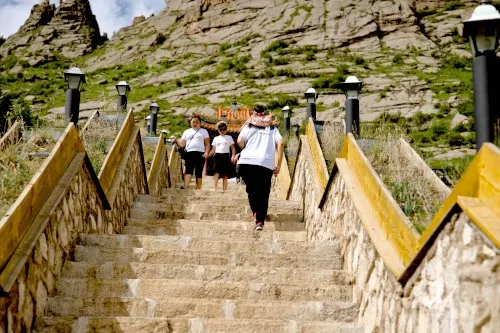
There are 108 white steps and eight black steps, representing humankind's ordinary and meaningless life. Around the temple, there are 108 prayer wheels containing three million mantras of the Buddha. Those who spin the wheels are believed to find happiness and fulfillment.
The main temple is at the top of the staircase, open to anyone who wants to meditate and free themselves from distractions. It's also a place to study the teachings and sutras of Mahayana Buddhism. The temple is designed to resemble an elephant, the Buddha's means of transport.
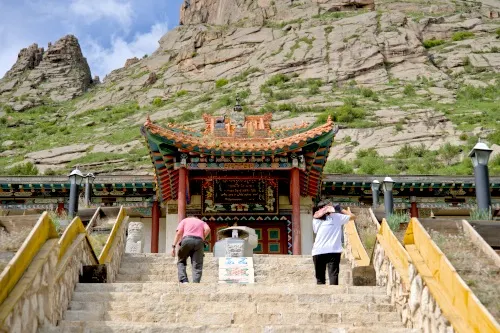
The view from the temple is breathtaking, with mountains, trees, grasslands, and layers of mountains against the backdrop of the blue sky. Despite having traveled to many different countries, it's one of the most beautiful landscapes I've seen in years. It's the perfect setting for meditation, and it's easy to see why the temple was built on top of this hill. The best place to take in the scenery is in front of the main temple.

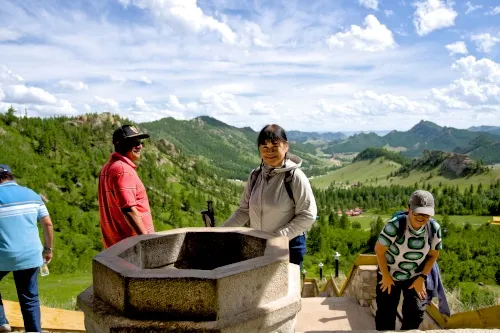

Milarepa Cave
A small pathway leads to a cave associated with Milarepa on the left side of the temple.

Milarepa was a big deal in Buddhist meditation around the 11th century. He overcame a tough early life and, with the guidance of his Guru, dedicated himself to a solitary life of meditation. He reached the highest state of enlightenment and never went through the cycle of life and death again. Out of compassion, he took on intense ascetic practices to achieve enlightenment and share his wisdom with others. His life greatly impacted the Buddhist faith and illuminated the path to wisdom for beings everywhere.

Also, inside the cave, there is a footprint of Buddha. These footprints serve as a reminder that Buddha was once present on Earth and left a spiritual path to be followed. There are over 3000 such footprints, with about 300 in Japan and more than 1000 in Sri Lanka. They often have distinct marks, such as Dharmachakra (the wheel of law) at the center of the sole, or 32, 108, or 132 auspicious signs of the Buddha engraved or painted on the sole.
Returning trip to the main entrance
On the return trip to the main entrance, I took a different route to visit the statue of Elder White. Known as the White Grandpa in Mongolia, he is a protective deity of nature that watches over Mother Earth. He will protect anyone who worships him and guard them from any ailment caused by other fierce land deities and natural disasters.
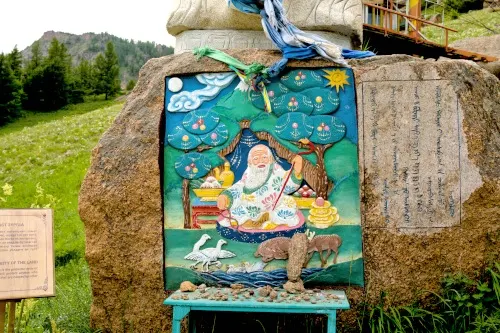
Next to Elder White's statue is a great prayer wheel of Kangyur, a collection of the Buddha's spoken words in 108 volumes. It contains the complete Kangyur in Tibetan. When the wheel is spun, a pointer stops at a specific number, corresponding to a board containing theories on meditation and enlightenment for practitioners to engage with and practice.

Next to the prayer wheel, there is a statue of Shakyamuni Buddha. Buddha was born in approximately 623 BC. He reached enlightenment and became a Buddha at age 35 after six years of meditation. It is said that by reciting the mantra "Om Mani Padme Hum," one can erase the bad deeds of 100 million years.
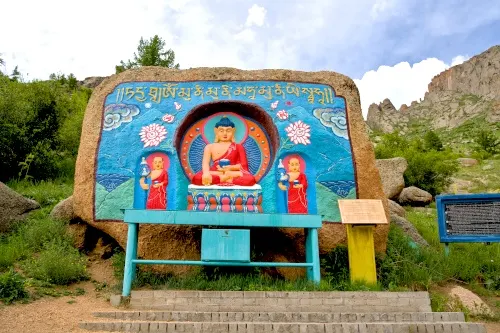
6. Horse riding and visiting a Mongolian family
Our last activity of the day was horse riding. However, since my wife has ridden horses in Nepal, traveling from Ghoripani to Tadapani, she's decided not to do it again. I was more interested in taking picturesque photographs, so we stayed and waited for them to return.
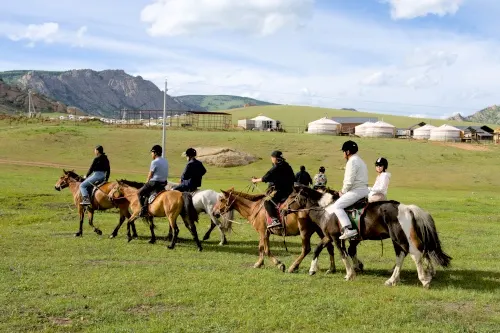
While waiting for them, we interacted with some local kids who were just a few years old.
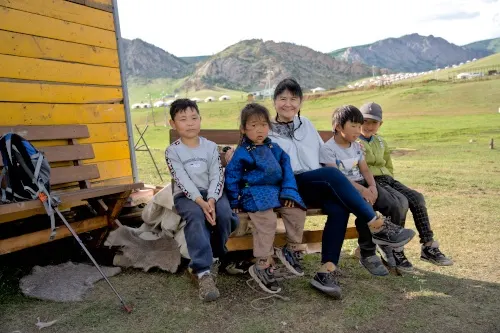
Even though we couldn't speak the same language, they led us to where they kept their small cattle.
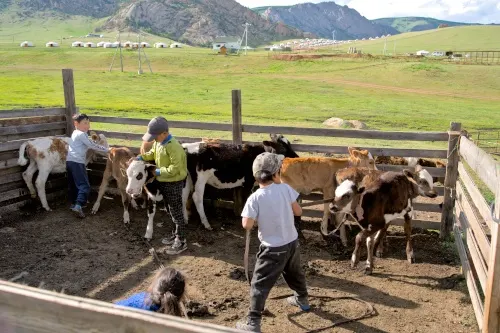
They tried to pull the cattle so we could touch them, but they didn't have enough strength. Then, they showed us where they lived, and their mother invited us inside the Ger and served us some traditional snacks.
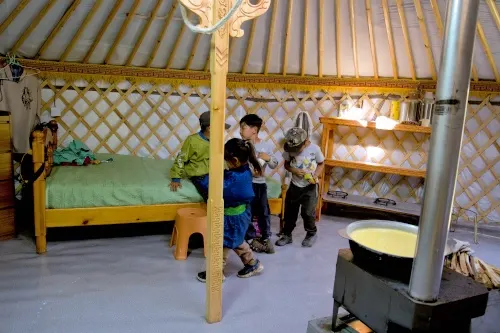
The kids were friendly and even showed us how to do archery and play basketball with us.
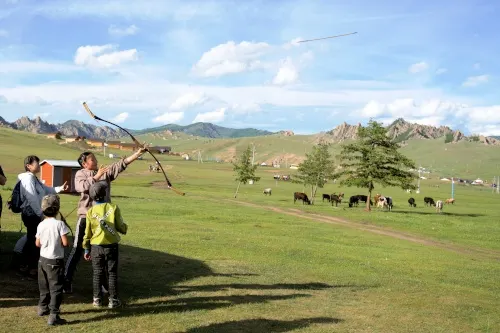
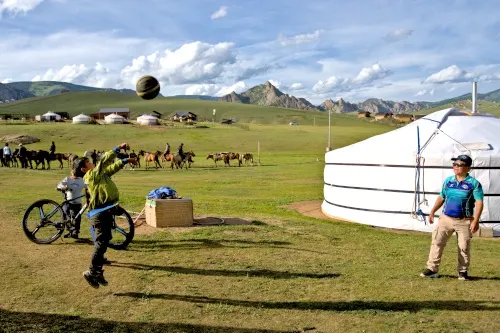
That wrapped up all the activities for today. In the following video, we will return to Ulaanbaatar for a city tour and other activities. Stay tuned.
🎞️ Watch the video shot during our trip
Please watch the video we made for our trip on YouTube. As below:
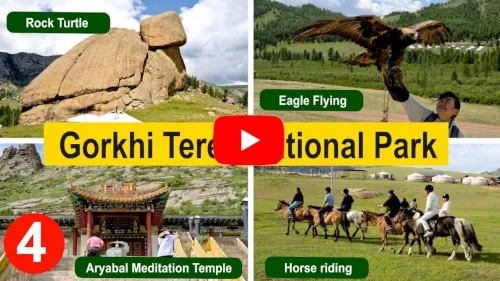
We have published a series of articles about Mongolia. To check them out, just click on this link.
Our tour is organized by Go Holiday 360 Sdn Bhd. You can contact them by visiting their website.
